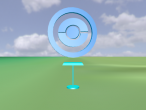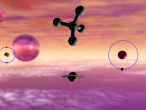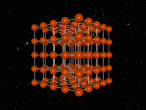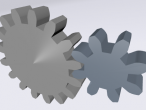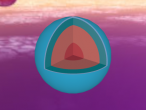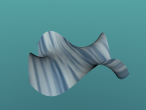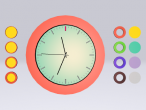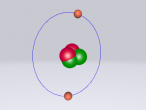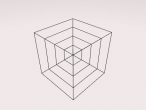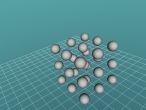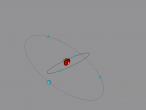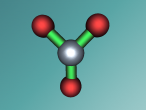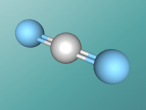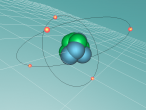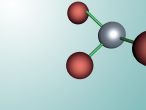Science
Boron Atom
Boron is the fifth atom in the periodic table, being a metalloid. The rare element, only made as compounds in the nature, has been used commonly for glass and glazes production. While its presence has been known since 1808, the first 99 percent pure boron was made only in 1909. A 3D model of this boron was made using the VRMath2.0, shown below. The Bohr model has been used to represent the element, as it simplifies the characteristics of electron movements. However, the model is not entirely accurate. In the process of programming the atom, many difficulties and challenges were experienced.

Water Molecule
What if the world had no water?....Water is one of the most crucial substances for the survival of living beings, and takes up approximately 70% of the world's surface. But what is water? Have you ever heard people say the word "H2O" and wondered why water was given that name? Well, "H", "2" and "O" are not just random letters and numbers put together to sound fancy; H2O is the molecular formula for water, representing the individual atoms in the compound. Water is an extremely unique molecule, having an interesting composition, structure and set of characteristics. So, let's flow right into it!
Aluminium Chloride Molecule
Atoms are the smallest particle of an element and are the basic building blocks of all matter. Atoms are composed of a nucleus which contain positively charged particles called protons and no charged particles called neutrons. Surrounding the nucleus are negatively charged electrons arranged in shells. These electrons exist in a cloud around the nucleus. When two electron clouds of different atoms interact, they bind together to form a molecule. An example of a molecular compound (a molecule that contains atleast two or more different elements) is Aluminium Chloride (AlCl2).
Aluminium Chloride consists of three Chloride atoms and one Aluminium atom which is shown in the image below. These atoms are structured in a trigonal planar with the three chlorine atoms surrounding the single aluminium atom with bonds, 120 degrees apart.The structure of the molecule is based upon temperature change. At temperatures around 190 degrees Celsius Aluminium Chloride converts to Al2Cl6. As temperatures increase further, the molecule is broken up into simple AlCl3 molecules. The aluminium and chloride atoms are bonded covalently, sharing electron pairs in the attractive and repulsive forces between the atoms. However this is only the case for the liquid or vapour form of Aluminium Chloride. When it is in solid form the atoms bond ionically, transferring electrons between atoms.
Aluminium atoms (Al) are composed of 13 protons and 14 neutrons in its nucleus, and 13 electrons surrounding the nucleus. The surrounding electrons are arranged in three shells, 2 in the first, 8 in the second and 3 in the third. Aluminium atoms are one of the lightest atoms with an atomic mass of 26.98 amu. Similarly, Chloride atoms have an atomic mass of 35.45 amu. Chloride atoms have 17 protons and 18 neutrons present in its nucleus and 17 electrons surrounding it in 3 shells. The first shell having 2 electrons, the second having 8 electrons and the third having 7 electrons.

Carbon Atom
All around us, everything we see is made up of incredibly small pieces of matter called atoms. These atoms, though incredibly small, are the building blocks for everything on earth and the rest of the universe, from buildings to people to even the stars. One particularly interesting atom that we will be discussing in this blog is Carbon. Carbon, though relatively small and simple compared to most other atoms, has played a massive role in the history of the earth, most notably being an essential part in all life known to humans.
Positioned at 6th on the periodic table, carbon is the sixth most common element in the universe, and fifteenth most common on earth. This is largely due to its relatively basic structure, and in its most common state, Carbon 12, it only has 6 protons, 6 neutrons and 6 electrons, with the electrons arranged into an inner shell of 2 and an outer shell of 4. It is considered fairly light, with an atomic weight of 12 amu, and is generally found as a solid on earth, with a melting point of 3550°C and boiling point of 3825°C. Carbon has fifteen isotopes, from Carbon 8-22, but Carbon 12 and 13 is considered stable. The isotope Carbon 14 is often used in Carbon dating on bones and pieces of plants to determine their date.
Carbon had been discovered by humans many thousands of years ago, and was first used in the form of charcoal at least 28 thousand years ago in rock art and cave paintings. At least 3000 years ago, diamonds, another allotrope of Carbon, were already being used as religious items and to engrave tools with, though their popularity later soared when they were used in jewellery. In 1772, Antoine Lavoisier first proved the existence of carbon, when after burning both diamonds and charcoal, he discovered they both released the same amount of carbon dioxide. Only 7 years later, Carl Wilhelm Scheele discovered graphite was also a form of carbon, and it is now used widely in a variety of areas, particularly in pencils. Though it had also been used for thousands of years in fires, coal, another form of carbon, also became incredibly important around this time and was essential to sparking the industrial revolution, and around 80% of our energy still comes from Carbon-based fossil fuels such as coal, oil and natural gasses. In modern times, Carbon in the form of various allotropes is still used in surprisingly similar ways to earlier times in history, though various other new uses for the element have been found throughout the last few thousands of years.
Another important quality of carbon is its valence electrons, which gives the atoms the ability to effectively bond with both more carbon atoms and a wide variety of other atoms, allowing for complex and diverse chemical bonds, structures and molecules that are essential to all life forms on earth. Without this unique property, as well as its small size, light weight and abundance on earth, life would be unable to exist, and the world would still be a barren wasteland, devoid of any living creature. This is by far one of the most important qualities of carbon, and another reason why it is such an important and special element.
Aluminium Chloride
Compounds are substances which are formed when two or more chemical elements are chemically bonded together. Compounds are found everywhere, from the water (H2O) which we drink, to the aluminium chloride we use as a deodorant. They consist of various atoms arranged in a specific structure, called molecules. Compounds are formed through two types of chemical bonding, covalent and ionic bonding. A covalent bond is formed when electrons are shared between atoms, whereas ionic bonds are formed through the attraction of oppositely (positive charge and negative charge) charged ions.





